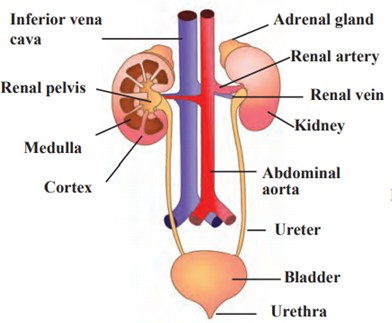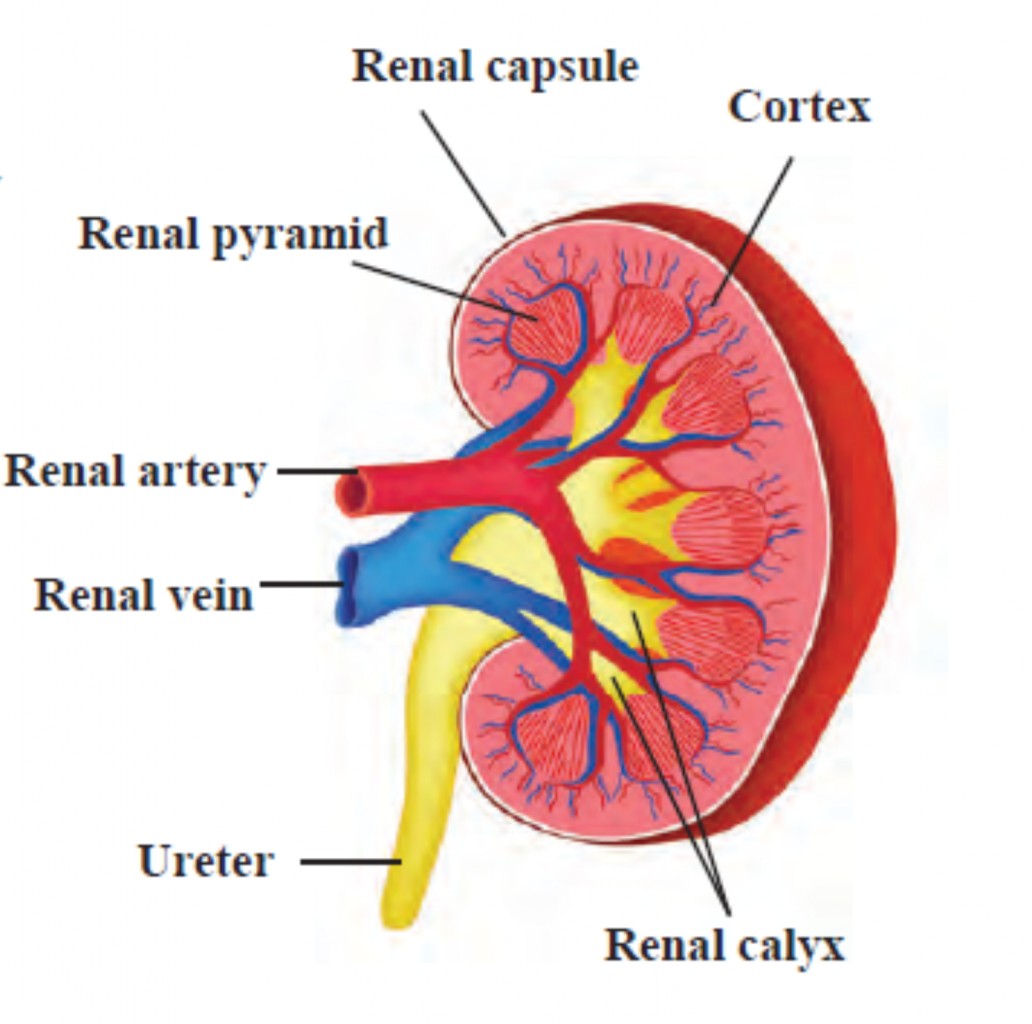Balbharti Maharashtra State Board Class 9 Science Solutions Chapter 15 Life Processes in Living Organisms Notes, Textbook Exercise Important Questions, and Answers.
Maharashtra State Board Class 9 Science Solutions Chapter 15 Life Processes in Living Organisms
Q.1. Fill in the blank and rewrite the completed statements 16
1. Movement or growth of any part of the plant in response to an external stimulus is called …………….
Ans Movement or growth of any part of the plant in response to an external stimulus is called ‘tropism’ or ‘tropic movement’.
2. In the space between the delicate central nervous system and its bony covering are the protective layers called the ……………. .
Ans In the space between the delicate central nervous system and its bony covering are the protective layers called the meninges.
3. are the structural and functional units of the nervous system.
Ans Neurons are the structural and functional units of the nervous system.
4. All parts of the plant are connected with tissues.
Ans All parts of the plant are connected with conducting tissues.
5. The functional unit of the kidney that performs the basic function of filtration is called a …………… .
Ans The functional unit of the kidney that performs the basic function of filtration is called a nephron.
6. Control and co-ordination in our body is also brought about with the help of certain chemical substances called …………… .
Ans Control and co-ordination in our body is also brought about with the help of certain chemical substances called hormones.
7. When an action or movement is to be brought about in the body, the work of the tissue comes last
in the sequence.
Ans When an action or movement is to be brought about in the body, the work of the muscular tissue comes last in the sequence.
8. In some plants, waste materials are present in the form of crystals of calcium oxalate which are called
……………
Ans In some plants, waste materials are present in the form of crystals of calcium oxalate which are called
raphides.
9. The spinal cord has a thread-like fibrous structure at its end which is called the …………… .
Ans The spinal cord has a thread-like fibrous structure at its end which is called the Filum terminale.
10. Plants give out water in the form of vapour through the on their leaves.
Ans Plants give out water in the form of vapour through the stomata on their leaves.
11. The hormone, , is effective in prevention and retardation of growth, leaf wilting, etc.
Ans The hormone, abscisic acid, is effective in prevention and retardation of growth, leaf wilting, etc.
12. Translocation is carried out in both the upward and the downward directions by the ……………. .
Ans Translocation is carried out in both the upward and the downward directions by the phloem.
13. of plants absorb these substances from the soil and transport them.
Ans Roots of plants absorb these substances from the soil and transport the
14. Nerves originating from the brain are called nerves.
Ans Nerves originating from the brain are called cranial nerves.
15. The continues downwards as the spinal cord.
Ans The medulla oblongata continues downwards as the spinal cord.
16. Gaseous substances are given out by the process of ……………
Ans Gaseous substances are given out by the process of diffusion.
Q. 2. Find the odd one out : 7
1. In the process of excretion.
Urethra, Adrenal gland, Bladder, Renal capsule.
Ans Adrenal gland
Adrenal gland are hormone secreting organs while remaining all function during the process of excretion.
2. Source of secretion.
Testosterone, Progesterone, Oestrogen, Saliva.
Ans Saliva
Saliva is an enzyme which is secreted by exocrine glands (salivary glands) while remaining are hormones secreted by endocrine glands.
3. Type of glands.
Adrenal gland, Pineal gland, Thyroid gland, Mammary gland
Ans Mammary gland
Mammary glands are glands with ducts or exocrine glands while remaining are endocrine or ductless glands.
4. Types of cells.
Nerve cells, Alpha cells, Beta- cells, F- cells
Ans Nerve cells
Nerve cells function in nervous control while remaining cells take part in hormone secretion in pancreas.
5. Fuction of the organ.
ANS, PNS, CNS, Reflex action.
Ans Reflex action
Reflex action is process carried out by Spinal cord while remaining are different parts of Nervous system.
6. Excretory products.
Gum, Resin, Rubber, Wood.
Ans Wood
Wood is not an excretory product of plant whike remaining are.
7. Pancreatic hormones.
Glucagon, Insulin, Thymosin, Somatostatin.
Ans Thymosin
Thymosin is secreted by Thymus gland while rermaining are secreted by Pancreas.
Q.3. Find co-related terms 5
- Roots : Root pressure :: Leaves : ……………
Ans Roots : Root pressure :: Leaves : Transpiration pull
- Urine formation : Excretion :: Homeostasis : ……………
Ans Urine formation : Excretion :: Homeostasis : Co-ordination
- Transport of food : phloem :: Transport of water : ……………
Ans Transport of food : phloem :: Transport of water : Xylem
4.Transportation in Day time : Transpiration pull :: Transportation in Night time : ……………
Ans Transportation in Day time : Transpiration pull :: Transportation in Night time : Root pressure
- Gibberellins : Stem elongation :: Cytokinins : ……………
Ans Gibberellins : Stem elongation :: Cytokinins : cell division
Q.4. Match the pair : 4
1.
| Column A | Column B |
| i. Growth of pollen tube towards ovule | a. Gravitropic movement |
| ii. Growth of root system | b. Chemotropic movement |
| c. Phototropic movement | |
| d. Growth-irrelevant movement |
Ans:
| i. Growth of pollen tube towards ovule | Chemotropic movement |
| ii. Growth of root system | Gravitropic movement |
3.
| Column A | Column B |
| i. Pancreas | a. Thymosin |
| ii. Thymus | b. Testosterone |
| c. Somatostatin | |
| d. Adrenaline |
Ans
| i. Pancreas | Somatostatin |
| ii. Thymus | Thymosin |
4.
| Column A | Column B |
| i. Growth of shoot system | a. Gravitropic movement |
| ii. Growth towards water | b. Chemotropic movement |
| c. Phototropic movement | |
| d. Hydrotropic movement |
Ans
| i. Growth of shoot system | Phototropic movement |
| ii. Growth towards water | Hydrotropic movement |
5.
Column A |
Column B |
i. Pituitary |
a. Glucagon |
ii. Parathyroid |
b. Parathormone |
c. Corticosteroid |
|
d. Oxytocin |
Ans
| i. Pituitary | Oxytocin |
| ii. Parathyroid | Parathormone |
Q. 5. State True or False 10
1. Excretion is a simpler process in plants than in animals.
Ans Excretion is a simpler process in plants than in animals.-True
2. Sensory neurons conduct impulses from sensory organs to the brain and the spinal cord.
Ans True – Sensory neurons conduct impulses from sensory organs to the brain and the spinal cord.
3. The autonomous nervous system consists of the nerves of involuntary organs.
Ans True – The autonomous nervous system consists of the nerves of involuntary organs.
4. Water is released into the atmosphere by leaves through the process of Condensation.
Ans False – Water is released into the atmosphere by leaves through the process of Condensation Water is released into the atmosphere by leaves through the process of evaporation.
5. In some plants, waste materials are present in the form of crystals of magnesium oxalate, called raphides.
Ans False – In some plants, waste materials are present in the form of crystals of magnesium oxalate, called raphides.
6. Urea, uric acid, ammonia, etc. are carbonated wastes.
Ans False – Urea, uric acid, ammonia, etc. are carbonated wastes.
7. Humans can respond to changes in their surroundings due to chemical control.
Ans False – Humans can respond to changes in their surroundings due to chemical control.
18. The right kidney is in a slightly lower position than the left.
Ans The right kidney is in a slightly lower position than the left.-True
9. Plants need organic substances like nitrogen, phosphorus, magnesium, manganese, sodium, etc.
Ans False – Plants need organic substances like nitrogen, phosphorus, magnesium, manganese, sodium, etc
10. The food absorbed by the digestive system is converted into energy.
Ans The food absorbed by the digestive system is converted into energy. -True
Q. 6. Name the following 6
- Name any two types of secretory cells present in Pancreas.
Ans Alpha-cells, Beta-cells, Delta-cells, P.P. cells or F-cells
- Name any two endocrine glands.
Ans Hypothalamus, Adrenal glands , Ovary, Pituitary gland, Thyroid gland and Parathyroid gland, Thymus, Pineal gland, Testis
- Name the two types of co-ordination control in humans.
Ans Nervous and Chemical
- Name the two types of nerves.
Ans Spinal and Cranial
- Name the two conducting tissues in plants.
Ans Xylem and Phloem
- Name the Any two growth relevant movements in plants.
Ans Phototropic movement, gravitropic movement, hydrotropic movement, chemotropic movement
Q.7. Multiple Choice Questions 22
1. Plants use impulses for transfer of information from one place to another.
a. electro-biological b. electro-chemical
c. chemo-physical d. hormonal
Ans Option b.
2. What type of tissues are Xylem and Phloem?
a. conducting tissues b. transport tissues
c. stem tissues d. nutrient tissues
Ans Option a.
3. Which fluid is present in the ventricles, central canal and spaces between the meninges?
a. cerebro-spinal b. cerebrumal c. cranial d. spinocular
Ans Option a.
4. Whenever there is an increase in blood-glucose level, certain cells in the get stimulated and as a
response, they release a greater quantity of insulin.
a. liver b. pancreas c. kidney d. nerves
Ans Option b.
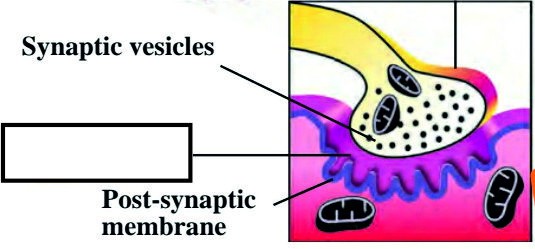 5. Label the part in the figure shown by an arrow?
5. Label the part in the figure shown by an arrow?
a. Synaptic cleft b. Synaptic vesicles
c. Post-synaptic membrane d. Dendrites
Ans Option a.
6. are the structural and functional units of the nervous system.
a. Dendrites b. Neurons c. Axons d. Synapse
Ans Option b.
7. The setup in the figure concludes which of the transportation method in plants?
a. Transpiration pull b. Stem pressure
c. Root pressure d. Root transfer system
Ans Option c.
8. Which of the following is a function of cerebellum?
a. Control of voluntary movements b. Body’s balance.
c. Intellectual activities. d. Decision-making
Ans Option b.
9. The brain of an adult human weighs about grams.
a. 1200-1300 b. 1600-1700 c. 1300-1400 d. 1400-1600
Ans Option c.
10. What is the characteristic feature of the plant in the figure?
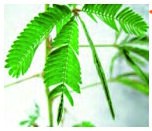
a. Touch sensitive. b. Fibrils present on the leaves.
c. Flower opens only at night. d. The ripened fruit dehisces.
Ans Option a.
11. Which system helps the hormones to reach different parts to their specific location?
a. nervous b. repiratory c. excretory d. circulatory
Ans Option d.
12. Which of the following is not a nitrogenous waste?
a. urea b. uric acid c. ammonia d. sugar
Ans Option d.
13. In unicellular organisms, …………… .
a. waste materials are directly eliminated across the cell surface.
b. waste excretion is complex.
c. waste materials are indirectly eliminated across the cell surface.
d. waste materials are directly eliminated in cytoplasm.
Ans Option a.
14. Adrenal gland is located
a. Anterolateral sides of trachaea b behind thyroid gland
c. Anterior end of each kidney d. At the base of brain
Ans Option c.
15. Through which process, a substance either synthesised or absorbed in one part of the body reaches another?
a. transpiration b. absorption c. synthesis d. transportation
Ans Option d.
16. Which of the following is controlled by the right side of the brain?
a. Analytical thinking b. Logical thinking
c. Holistic thinking d. Language
Ans Option c.
17. Which of the organ does take part in the process of excretion?
a. Adrenal gland b. Urethra c. Medulla d. Ureters
Ans Option a.
18. Nerve cells and neuroglial cells together form which structure?
a. Myelin sheath b. Nerves
c. Synaptic vesicles d. Schwann’s cell
Ans Option b.
19. Which the hormone produced in ovaries which cause development of secondary sexual characters in females?
a. Adrenaline b. Non-adrenaline c. Oestrogen d. Oxytocin
Ans Option c.
20. Which ductless gland is located on either side of uterus in women?
a. Testis b. Pancreas c. Ovary d. Adrenal gland
Ans Option c.
21. The functional unit of the kidney that performs the basic function of filtration is called a …………….
a. Bowman’s capsule b. Glomerulus c. Kidney d. Nephron
Ans Option d.
22 . The largest cells in the human body are.
a. Synaptic cells b. Axonal cells c. Dendrites d. Nerve cells
Ans Option d.
Q.8. Write Short Notes 10
1. Nerve cell
Ans i. Special types of cells which conduct impulses from one place to another in the body are called neurons.
ii. Neurons are the structural and functional units of the nervous system. Nerve cells, the largest cells in the human the body, may measure up to a few metres in length.
iii. Nerve cells have the ability to generate and conduct electrochemical impulses.
iv. The cells that support the nerve cells and help in their functioning are called neuroglia. Nerve cells and neuroglial cells together form the nerves.
2. Root pressure
Ans i. Root cells are in contact with water and minerals in the soil. Water and minerals enter the cells on the root surface due to differences in concentration.
- As a result, these cells become turgid. These turgid cells exert pressure on the adjacent cells. This is called ‘root pressure’.
- Under the effect of this pressure, water and minerals reach the xylem of the roots and to reduce this difference in concentration they are continuously pushed forward.
- As a result of this continuous movement, a water column is formed, which is continuously pushed ahead. This pressure is sufficient to lift the water up in shrubs, small plants and small trees.
3. Human brain
Ans i. The brain of an adult human weighs about 1300 – 1400 grams and consists of approximately 100 billion neurons.
ii. Cerebrum is largest part of our brain and consists of two cerebral hemispheres. These hemispheres are joined with each other with the help of tough fibres and nerve tracts.
iii. Cerebellum is the smaller part of the brain situated below the cerebrum at the back of the cranial cavity.
iv. Medulla oblongatais the hind-most part of brain. There are two triangular swollen structures called pyramids on the upper side of medulla oblongata. The medulla oblongata continues downwards as the spinal cord.
4. Transpiration
Ans i. Plants give out water in the form of vapour through the stomata on their leaves.
ii. Two cells called guard cells are present around the stomata. These cells control the opening and closing of stomata. Transpiration occurs through these stomata.
iii. Water is released into the atmosphere by leaves through the process of evaporation. As a result, water level in the epidermal layer of the leaf decreases.
Iv. Water is brought up to the leaves through the xylem so as to compensate for the lost water. Transpiration helps in absorption of water and minerals and distribution to all parts of the plant.
5. Reflex action.
Ans i. An immediate and involuntary response given to a stimulus from the environment is called a reflex action.
i. Sometimes we react to an incident without any thinking on our part or control over the reaction.
ii. This is a response given to a certain stimulus from the surroundings.
iii. In such situations, proper control and co-ordination is achieved even without intervention of the brain.
Q.9. Attempt the following. 2
1. Complete the chart.
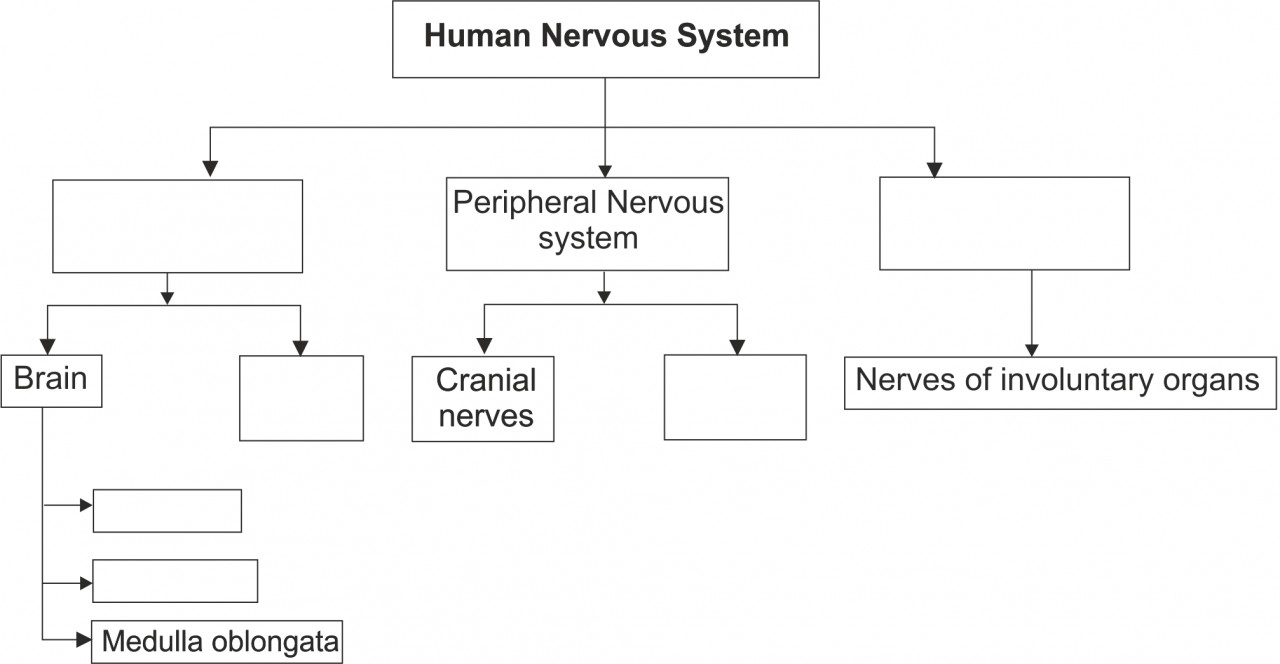
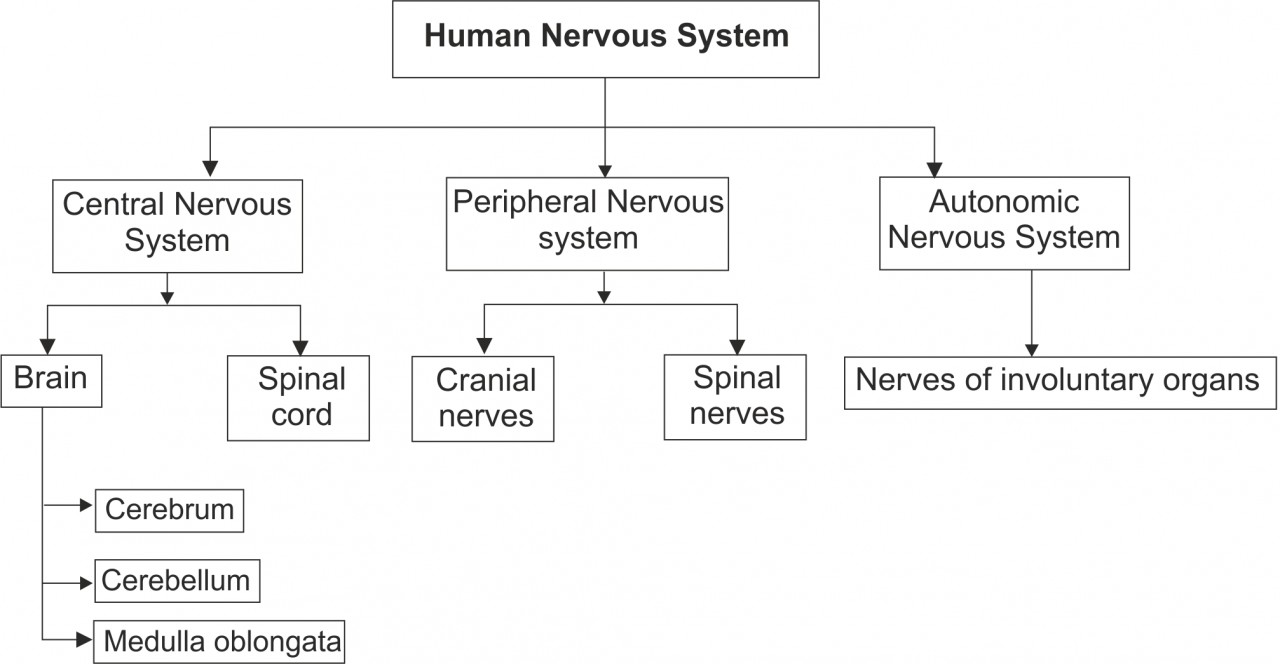 Ans
Ans
Q.10. Complete the given flow chart / table / diagram 4
1
| Type of movement | Movement influenced by |
| Gravitropic movement | …………… |
| Phototropic movement | …………… |
| …………… | Specific chemicals |
| …………… | Water |
Ans
| Type of movement | Movement influenced by |
| Gravitropic movement | Gravity |
| Phototropic movement | Sunlight or light |
| Chemotropic movement | Specific chemicals |
| Hydrotropic movement | Water |
2
| Organ of a system | Function of the organ |
| …………… | Reflex action |
| …………… | Formation of urea |
| …………… | Formation of urine |
| …………… | Control of involuntary activities |
Ans
| Organ of a system | Function of the organ |
| Spinal cord | Reflex action |
| Liver | Formation of urea |
| Kidney | Formation of urine |
| Cerebellum | Control of involuntary activities |
Q.11. Distinguish between 6
1. Excretion in Plants and Excretion in Animals.
Ans
| Excretion in Plants | Excretion in Animals | |
| i. | Excretion is a simple process in plants. | Excretion is a complex process in animals. |
| There is no special organ or system for excretion in plants. | There is a special organ or system for excretion in animals.i.e. kidneys. | |
| ii. | ||
| Most of the waste substances of plants are stored in vacuoles of the plant cells. | In animals waste is released into blood and then separated by kidneys and stored in the bladder. | |
| iii. | ||
| Waste is excreted in the form of raphides, gum, resin, latex of rubber, etc. | Waste is excreted in the form of urine, ammonia or uric acid. | |
| iv. | ||
2. Movement in plants and Movement in animals
Ans
| Movement in Plants | Movement in Animals | |
| Plant do not have systems like the nervous system or muscular system. | Animals have systems like the nervous system or muscular system. | |
| i. | ||
| Movements are mainly in the form of responses given to the stimuli. | Movements can be in the form of voluntary or involuntary responses. | |
| ii. | ||
| The are anchored in soil and do not posses limbs. | They can move free with the help of the limbs by voluntary actions. | |
| iii. | ||
| The movements can be growth relevant or growth irrelevant. | The growth does not depend on the movement at any time in life. | |
| iv. | ||
- Spinal nerves and Cranial nerves
Ans
| Spinal nerves | Cranial nerves | |
| Nerves originating from the spinal cord are called spinal nerves. | Nerves originating from the brain are called cranial nerves. | |
| i. | ||
| ii. | There are 31 pairs of spinal nerves. | There are 12 pairs of cranial nerves. |
| These are associated with arms, legs, skin and some other parts of the body. | They are associated with various parts in the head, thorax and abdomen. | |
| iii. | ||
| iv. | They are associated with reflexes. | They are not associated with the reflex action. |
Q.12. Give scientific reasons 6
1. Some movements of plants are related with growth.
Ans i. In plants, movements are mainly in the form of responses given to the stimuli.
ii. In response to presence of water, the roots grow longer and deeper in soil or the leaves grow towards the sunlight leads to growth in height and so on.
iii. As the movements lead to growth of the plant, these movements occur as responses.
iv. Therefore, Some movements of plants are related with growth.
2. Colocasia leaves are rubbed with lemon or tamrind juice before cooking.
Ans: i. Colocasia leaves excrete the waste in the form of crystals of calcium oxalate, known as raphides.
- These crystals if eaten directly can cause serious itching and irritation in the mouth and neck region.
iii. When rubbed with lemon or tamarind juice, the acids in the juices neutralize these crystals and the raphides are dissolved.
iv. These makes the colocasia leaves fit to consume and thus they are rubbed with any sour juice with mild acids particularly lemon or tamarind juice.
3. An excess of alcohol in the body causes one to lose control over itself.
Ans i. Alcohol can damage nerve function when it accumulates inside the body, a serious form of nerve damage.
ii. Alcohol interacts with the CNS, especially with cerebellum which is responsible for maintaining body balance.
iii. Also the other parts of brain are affected due to which voluntary actions become uncontrolled and thus brain loses the control over the body.
iv. Hence, an excess of alcohol in the body causes one to lose control over itself.
Q.13. Give examples : 10
1. Give any 4 Hormones in plants.
Ans Auxins, Gibberellins, Cytokinins, Abscisic acid.
2. Give any 4 Ductless glands.
Ans Hypothalamus, Adrenal glands, Ovary, Pituitary gland, Thyroid gland and Parathyroid gland, Thymus, Pineal gland, Testis
3. Give any 4 Waste products in animals.
Ans Urea, Uric acid, Ammonia, Carbon dioxide, Sweat, etc.
4. Give any 4 Pancreatic hormone releasing cells.
Ans Alpha-cells, Beta-cells, Delta-cells, P.P. cells or F-cells.
5. Give any 4 Waste products in plants.
Ans Raphides, gum, resin, latex of rubber, etc.
Q.14. Explain the statement 27
1. Cerebrum is largest part of our brain.
Ans i. . The central nervous system consists of the brain and spinal cord.
ii. Cerebrum consists of two cerebral hemispheres.
iii. These hemispheres are joined with each other with the help of tough fibres and nerve tracts.
iv. The cerebrum occupies two-thirds of the brain. Hence, it is also called the large brain.
v. Its surface has deep, irregular ridges and grooves which are called convolutions.
vi. Convolution increases the surface area of the cerebrum and therefore a large number of nerve cells can be accommodated.
2. The nervous system consists of a well-organized network of nerves. Discuss
Ans i. When an action or movement is to be brought about in the body, the work of the muscular tissue comes last in the sequence.
- Movement of muscle cells is essential to bring about any activity. When cells contract to change their shape, movement occurs at cellular level.
- Impulses are conducted in the body and these impulses are finally conveyed by nerve cells to muscle cells or glands.
- Muscle cells have the ability to change their shape due to a special type of protein.
- Besides, due to these same proteins, cells become able to respond to electrical impulses of nerves.
- Thus, we can say that the nervous system consists of a well-organized network of nerves which can conduct information in the form of electrical impulses from one part of the body to other.
3. As a response to changes in the surroundings, plant hormones bring about various movements in plants. Explain.
Ans i. In plants, movements are mainly in the form of responses given to the stimuli.
ii. Some specific movements of the plants do not lead to the plant’s growth. Such movements are called ‘growth- irrelevant movements’.
iii. Some movements of plants are related with growth and all such movements are collectively called ‘growth relevant movements’.
iv. Plants use electro-chemical impulses for transfer of information from one place to another.
v. Hence, we can infer that the information about the touch must have been relayed within the plant from one place to another.
vi. Plant cells change their shape by increasing or decreasing their water content and thereby bring about the movements of plants.
3. Excretion is a simpler process in plants.Discuss
Ans i. Excretion is a simpler process in plants than in animals.
ii. There is no special organ or system for excretion in plants.
iii. Gaseous substances are given out by diffusion.
iv. Most of the waste substances of plants are stored in vacuoles of leaf-cells and in flowers, fruits and the bark of the stem.
v.After some time these parts fall off. Some other waste materials are stored in old and worn xylem in the form of resin and gum.
vi. Some waste materials are also given out through roots into the surrounding soil.
4. Explain Growth relevant movements in plants.
Ans i. Movement or growth of any part of the plant in response to an external stimulus is called ‘tropism’ or ‘tropic movement’.
ii. The shoot system of any plant responds to the light stimulus i.e. it grows towards the source of light. The movement shown by plants towards the source of light is called ‘Phototropic movement’.
iii. The root system of plants responds to stimuli like gravitation and water. These responses are called ‘gravitropic movement’ and ‘hydrotropic movement’ respectively.
iv. Movement shown by plants in response to specific chemicals is called ‘chemotropic movement’.
v.For example, the growth of the pollen tube towards the ovule is a chemotrophic movement.
vi. All the above-mentioned movements of plants are related with growth; hence all such movements are collectively called ‘growth relevant movements’.
5. Several different organ systems function in multicellular organisms.
Ans i. In multicellular organisms, there is co-ordination between the different organ systems or organs and the stimuli in the surrounding.
ii. Depending upon this, we can say that systematic regulation of different processes can be called control and bringing about the different processes in the proper sequence can be called co-ordination.
iii. If any activity in the body is to be completed successfully, proper co-ordination between different systems and organs participating at different steps of that activity is necessary.
iv. If due to lack of co-ordination or some other factor, there is confusion at any step the activity may not get completed. There should not be any randomness at any step.
v. There needs to be proper co-ordination between internal activities of the body resulting from various factors like body temperature, water-level, enzyme-level, etc. or stimuli arising in the surrounding environment.
vi. Proper co-ordination between various systems of an organism helps to maintain a state of equilibrium called ‘homeostasis’ which is necessary for the optimal efficiency of the body.
6. All parts of the plant are connected with conducting tissues.
Ans i. Most animals move from place to place but plants do not. There are many dead cells in the plant body.
ii. They need less energy as compared to animals. Plants need inorganic substances like nitrogen, phosphorus, magnesium, manganese, sodium, etc.
iii. Soil is the nearest and richest source of these substances. Roots of plants absorb these substances from the soil and transport them.
iv. There are specific types of tissues to perform this function known as conducting tissues.
v. All plants mainly have two types of conducting tissues- Xylem and Phloem.
vi. The xylem conducts the water whereas the phloem conducts the food.
Therefore, all parts of the plant are connected with these conducting tissues to transfer food and water to all the parts of the plant.
7. It is very important that hormones are secreted only in the required quantity. Explain.
Ans i. Control and co-ordination in our body is also brought about with the help of certain chemical substances called hormones.
Ii Hormones are secreted by endocrine glands. These glands are also called ductless glands.
iii. These glands do not have any arrangement of their own to either store or carry their secretions.
iv. Hence, as soon as hormones are produced, they are directly released into the blood circulation.
v. Their secretion defines the blood concentration and create corresponding effect.
vi. For example, whenever there is an increase in blood-glucose level, certain cells in the pancreas get stimulated and as a response, they release a greater quantity of insulin. If secretion is in very large quantity the blood sugar level will go down and the blood pressure decreases.
And so it is very important that hormones are secreted only in the required quantity.
8. Transportation of food requires energy. Explain
Ans i. Translocation of materials is not a simple physical process; it requires energy. This energy is obtained from ATP.
ii. Whenever food material like sucrose is transported towards a part of a plant via the phloem with the help of ATP, the water concentration decreases in that part.
iii. As a result, water enters the cell by the process of diffusion. The pressure on the cell wall increases due to the increase in cellular contents.
iv. Due to the increased pressure, food is pushed into the neighbouring cells where the pressure is low.
v. This process helps the phloem to transport the materials as per the need of the plant.
vi. During flowering season, the sugar stored in roots or stem is transported towards the floral buds to make them open and blossom.
Q.15. Draw / Label the diagram 15
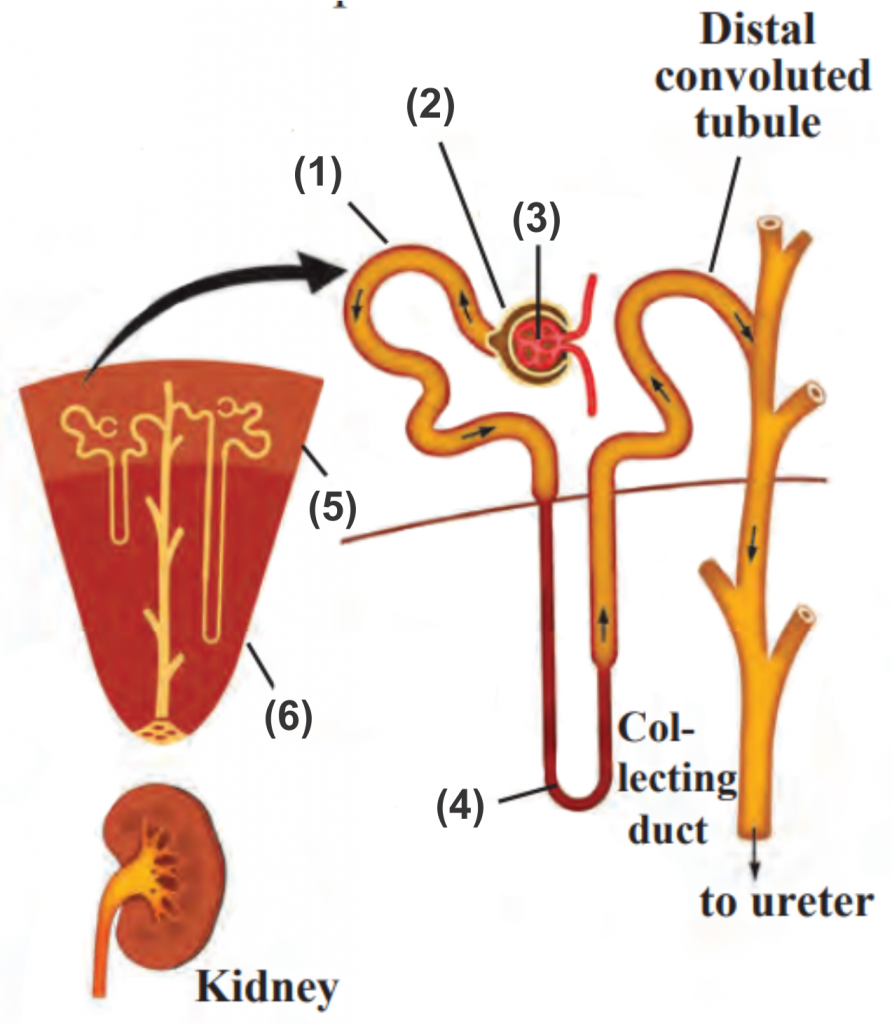 1. Nephron
1. Nephron
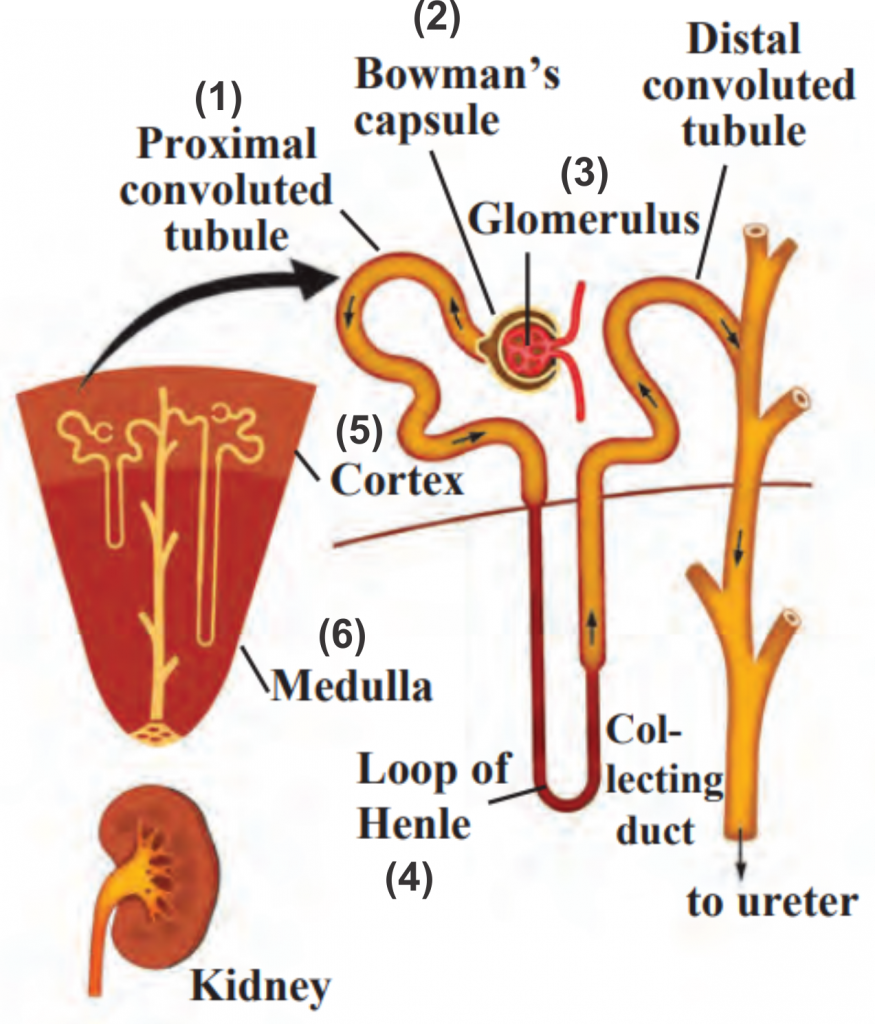 Ans :
Ans :
2. Label the diagram.
Human excretory system
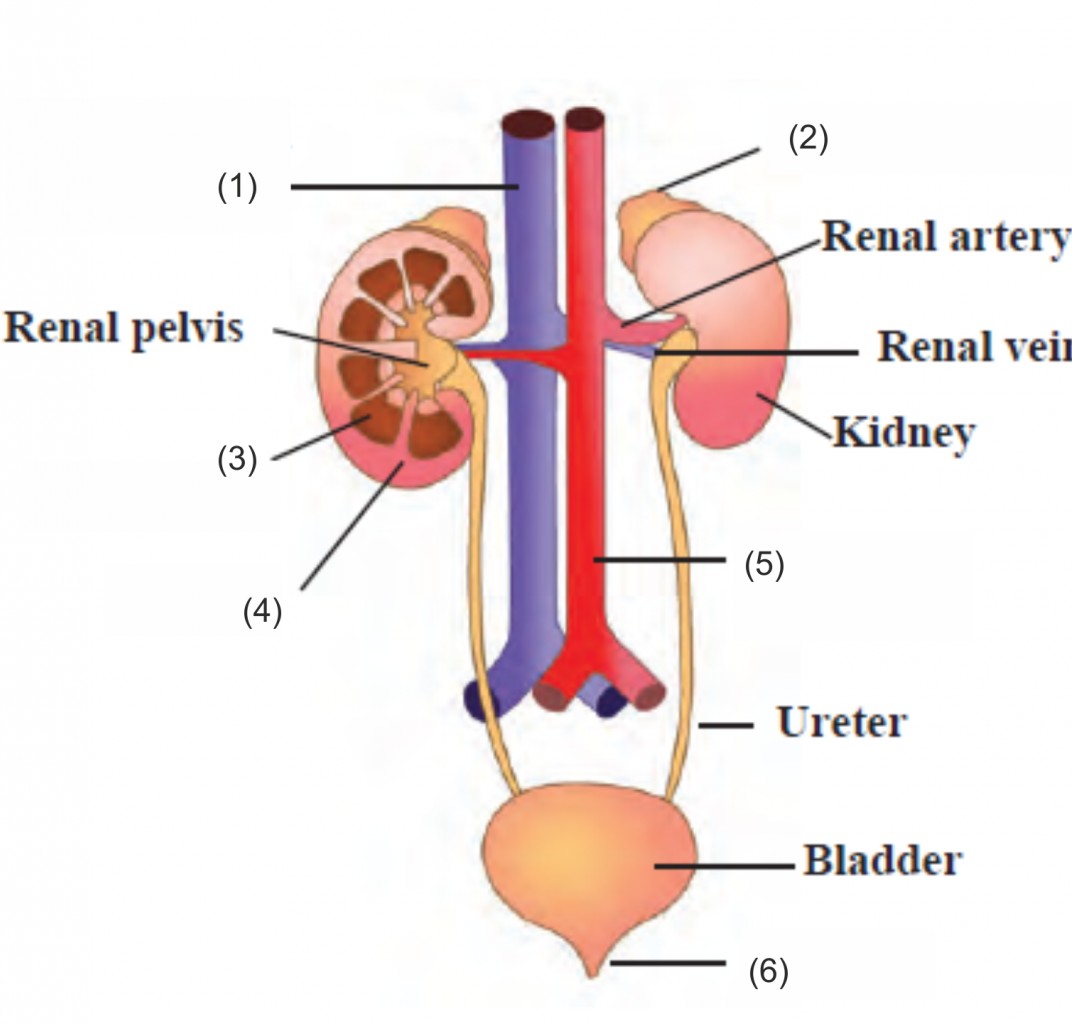
Ans:
3. Label the diagram.:Human brain
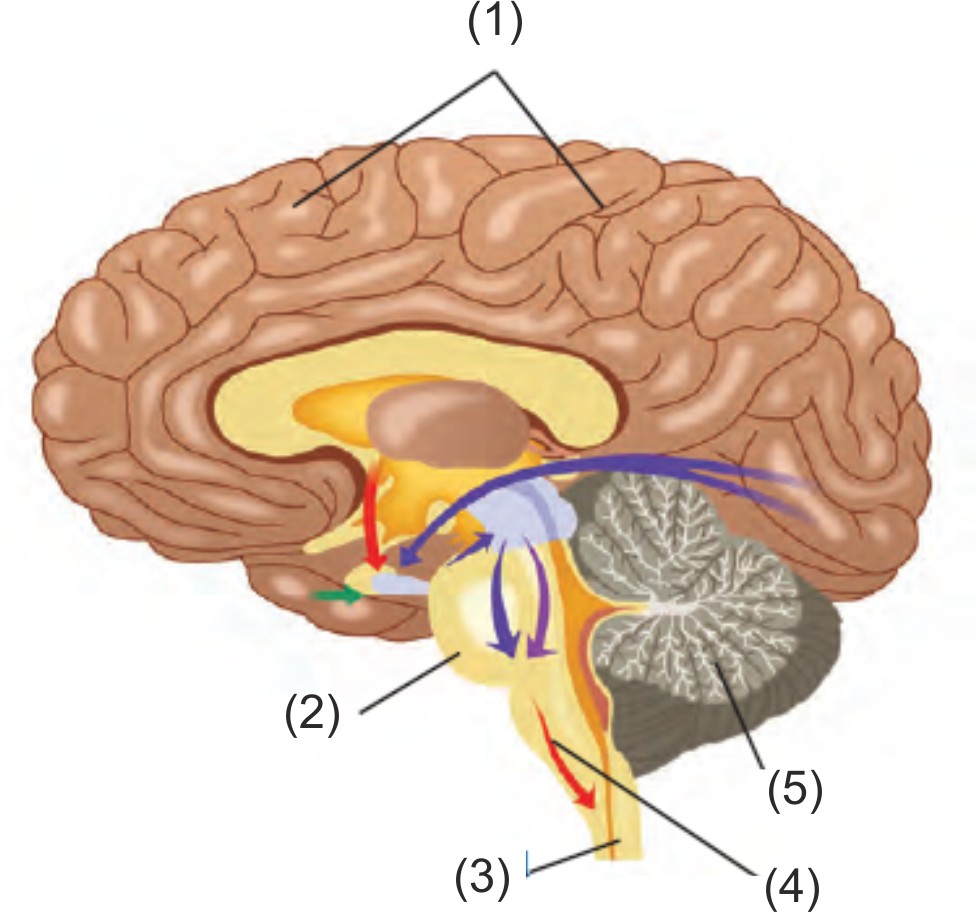
Ans:
4. Label the diagram. kidneys
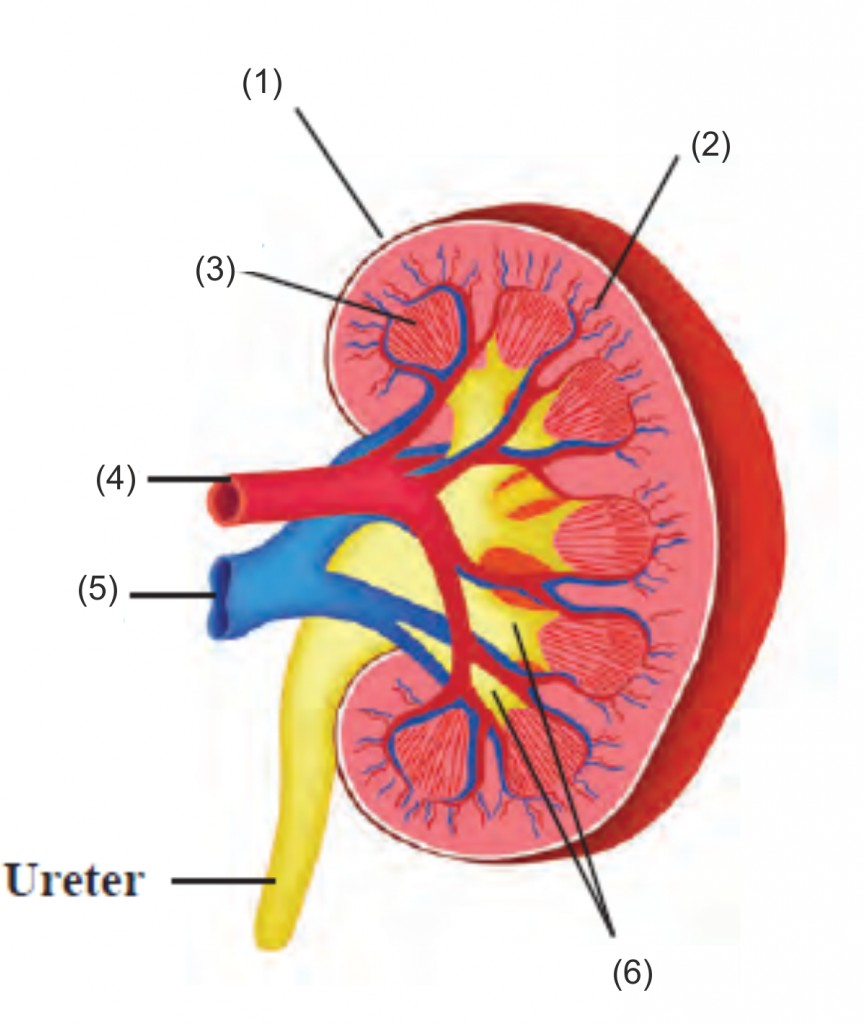
Ans:
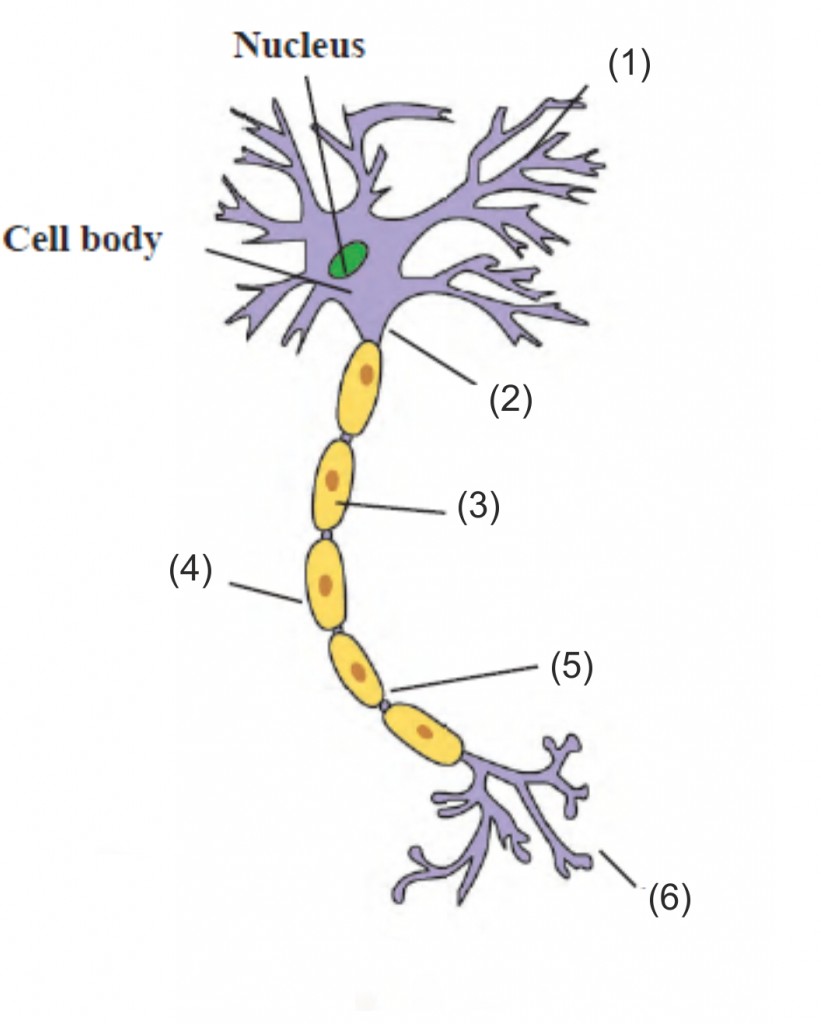 5. Label the diagram. Nerve cell
5. Label the diagram. Nerve cell
Ans:
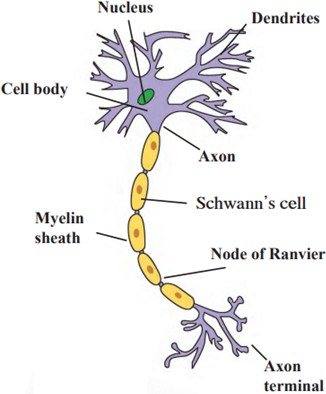
Q.16. Attempt the following. 15
1. i. What are endocrine glands?
ii. What is the observed difference in nervous and chemical control systems?
iii.Give two hormones secreted by Thyroid gland.
Ans i. Endocrine glands are ductless glands which secrete hormones directly into the blood.
ii. A marked difference between these two systems is that nerve impulses are fast but short lived whereas the action of hormones is very slow but long lasting.
iii. Thyroxine and Calcitonin.
2. Name the hormones of the following endocrine glands and their function. Pituitary
Ans Pituitary
a. Growth hormone stimulates growth of bones.
b Adrenocorticotropic hormone stimulates adrenal gland.
c. Thyroid stimulating hormone stimulates thyroid gland. d. Prolactin stimulates milk producting.
e. Follicle stimulating hormone controls growth of gonads.
f. Latenizing hormone controls menstrual cycle and ovulation.
G .Oxytocin contracts uterus during parturition.
h. Antidiuretic hormone regulates water level in the body.
3. Name the hormones of the following endocrine glands and their function. Thymus, Testis, Ovary.
Ans i. Thymus
Thymosin controls the cells which give rise to immunity.
Testis
Testosterone stimulates growth of secondary sexual characteristics like beard, mustache, hoarse voice, etc in men
Ovary
Oestrogen stimulates growth of endometrium. Also stimulates growth of secondary sexual characteristics in women.
Progesterone prepares the endometrium for conception and maintains the pregnancy.
4. Nayana took a small plant of balsam with its roots intact and kept it in the water containing eosin for 2 – 3 hours.
i. What changes will be observe in flower and leaves?
ii. What are the two main fuctions of roots?
iii. What is the following natural phenomena known as?
Ans i. The leaves and the flowers turn into orange red colour slowly.
ii. The two main functions of roots are anchorage and absorption through the soil.
iii. This natural phenomena is called as root pressure.
5. Name the hormones of the following endocrine glands and their function. Thyroid, Adrenal.
Ans i. Thyroid
a. Thyroxine controls growth of body and metabolic activities.
b. Calcitonin controls calcium metabolism and calcium level in blood.
ii. Adrenal
a. Adrenaline and Nor-adrenaline controls behaviour during crisis and emotional situations.
b. They also stimulate heart and its conducting tissue and metabolic processes.
c. Corticosteroid maintains balance of Na+ and K+ and stimulates metabolism.
Q.17. Complete the sentences in paragraph 15
1. Complete the paragraph.
(electrical, Organs, muscles, functional, homeostasis, stable, cells, hormones)
Human body is multi-cellular and made up of different organ systems that coordinate with each other. …………… are made up of tissues, which in turn are made up of specific types of These cells
communicate with each other using …………… impulses and certain chemicals like Coordination of
this communication is significant so as to meet up the requirements of the cells and to maintain
…………… internal environment. There also needs to a be proper coordination between the internal activities of the body resulting from various factors like body temperature, water – level etc. to maintain required
for optimal efficiency of the body.
Ans Human body is multi-cellular and made up of different organ systems that coordinate with each other. Organs are made up of tissues, which in turn are made up of specific types of cells. These cells communicate with each other using electrical impulses and certain chemicals like hormones. Coordination of this communication is significant so as to meet up the requirements of the cells and to maintain stable internal environment. There also needs to a be proper coordination between the internal activities of the body resulting from various factors like body temperature, water – level etc. to maintain homeostasis required for optimal efficiency of the body.
2. Complete the paragraph.
(nasal, carbon dioxide, respiratory, alveoli, oxygen, bronchi)
The system brights oxygen into our body and releases carbon dioxide from the body. It consists of
nose, pharynx, larynx, trachea, …………… and lungs. Air is drawn into the chambers through nostrils,
where it is filtered and humidified and enters into the lungs down to the From there, exchange of
gases occurs i.e. …………… enters into the blood and from blood enters into the lungs. The carbon
dioxide in lungs is releases out during exhalation.
Ans The respiratory system brights oxygen into our body and releases carbon dioxide from the body. It consists of nose, pharynx, larynx, trachea, bronchi and lungs. Air is drawn into the nasal chambers through nostrils, where it is filtered and humidified and enters into the lungs down to the alveoli. From there, exchange of gases occurs i.e. oxygen enters into the blood and carbon dioxide from blood enters into the lungs. The carbon dioxide in lungs is releases out during exhalation.
3. Complete the paragraph:
(liver, glomerulus, nephron, vertebral column, Bowman’s capsule, capillaries)
The two bean-shaped kidneys are situated one on either side of the , on the posterior side of
abdomen. The functional unit of the kidney that performs the basic function of filtration is called a
………………….. . Each nephron has a cup-like, thin-walled upper part called the The network of
capillaries in it is called a ………………. . The urea produced in the comes into the blood. When
the urea-containing blood comes into the glomerulus, it is filtered through its ………………….. and urea and other similar substances are separated from it.
Ans The two bean-shaped kidneys are situated one on either side of the vertebral column, on the posterior side of abdomen. The functional unit of the kidney that performs the basic function of filtration is called a nephron. Each nephron has a cup-like, thin-walled upper part called the Bowman’s capsule. The network of capillaries in it is called a glomerulus. The urea produced in the liver comes into the blood. When the urea- containing blood comes into the glomerulus, it is filtered through its capillaries and urea and other similar substances are separated from it.
4. Complete the paragraph:
(amino acids, fruits, translocation of materials, phloem, seeds, leaves, xylem)
The food produced in …………… is transported to each cell in the plant body. Excess food, except , is
stored in roots, …………… and …………… . This process is called It is carried out in both the upward
and the downward directions by the …………… .
Ans The food produced in leaves is transported to each cell in the plant body. Excess food, except amino acids, is stored in roots, fruits and seeds. This process is called translocation of materials. It is carried out in both the upward and the downward directions by the phloem.
5. Complete the paragraph:
( reflex action, muscle cell, nerve cells, axon, dendrite, synapse )
The milk was on the stove. Rasika was engrossed watching television. She smelled something burning. She ran towards the kitchen. The milk was boiling over. She held the vessel with her bare hands but, screaming, she let it go at once. This activity was controlled by …………………. Special ends of in these cells
collected the information, from where it was transferred to the cell body and then towards the terminal end of the ………………….. . The chemicals produced at the terminal end passed through the minute space i.e.
……………………. . In this way, impulse is conducted in the body and the process of was
completed by conducting the impulses to ……………………
Ans The milk was on the stove. Rasika was engrossed watching television. She smelled something burning. She ran towards the kitchen. The milk was boiling over. She held the vessel with her bare hands but, screaming, she let it go at once. This activity was controlled by nerve cells. Special ends of dendrite in these cells collected the information, from where it was transferred to the cell body and then towards the terminal end of the axon. The chemicals produced at the terminal end passed through the minute space i.e. synapse. In this way, impulse is conducted in the body and the process of reflex action was completed by conducting the impulses to muscle cell.
Q.18. Write answers based on given diagram 6
 1. Transpiration through Leaves.
1. Transpiration through Leaves.
- Through which part transpiration occurs? (1/2 mark)
ii.Which tissue brings up the water? (1/2 mark)
iii. Which cells are present control opening and closing of stomata? (1 mark)
iv. How is water lost through stomata? (1/2 mark)
v.The complete process is known as …………… . (1/2 mark)
Ans i. Transpiration occurs through these stomata.
ii. Water is brought up to the leaves through the xylem.
iii. Guard cells
iv. Water is released into the atmosphere by leaves through the process of evaporation.
v.Transpiration pull.
2.
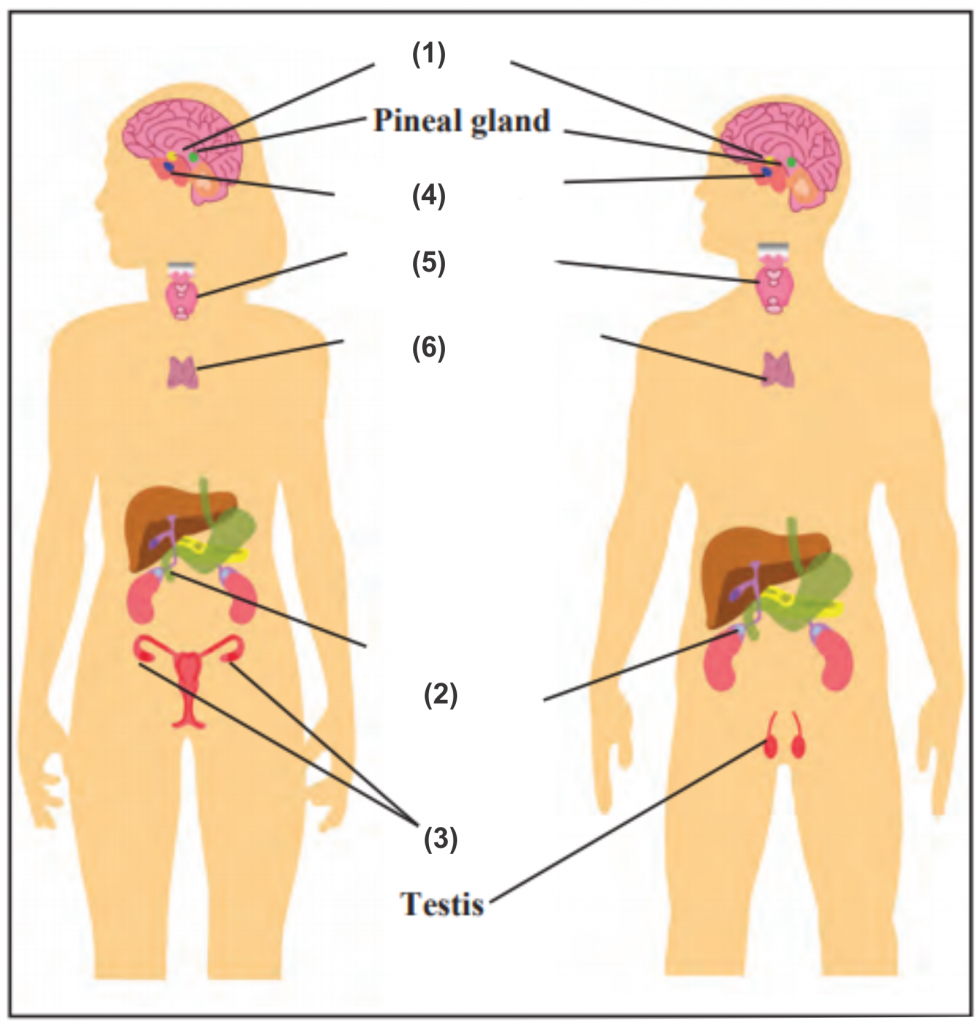
i. Which nerve carried the impulse to the point marked 3?
ii. Which is the nerve shown by 4?
iii. Which is the organ marked as 5?
iv. At 6, which nerve is conducting the response impulse?
v. At 7, where has the impulse reached?
Ans i. . Sensory nerve.
ii. Association nerve.
iii. Spinal cord.
iv. Motor nerve.
v. Muscles in the hand.
Q.19. Answer the following 18
1. Describe the transportation system in plants.
Ans i. Plants have two types of conducting tissues i.e. xylem (conducts water) and phloem (Atmosphere food).
ii. During the process of transpiration, water from leaves gets released into the
iii. As a result, water level in the epidermal layer of the leaf decreases.
iv. Water absorbed by roots is transported up to the leaves through the xylem so as to compensate for the water loss due to transpiration.
v. The food produced by leaves is transported to each cell of the plant body through phloem.
vi. When the food material like sucrose, is transported towards a part of a plant through phloem, with the help of ATP, the water concentration decreases in that part.
vii. Due to this, water enters the cell by diffusion process. increase in cellular content results in increase in pressure on the cell wall.
viii. Due to this increased pressure, food is pushed into the neighbouring cells where the pressure is low.
ix. This process helps the phloem to transport food material from leaves to growing tissues.
2. How is excretion in plants useful to human beings?
Ans i.. Human beings make use of waste products produced in plants.
ii. Some excretory products of plants and their uses are as follows:
iii. Latex – It is used for making rubber products.
iv. Resin – It is used for making varnishes, paints and gum.
v. Gum – It is used as an adhesive.
3. What is meant by co-ordination?
Ans i. Co-ordination is bringing about the different processes of body in the proper sequence.
ii. Proper co-ordination between different systems and organs participating at different steps is necessary for successful completion of a body activity.
iii. Due to lack of co-ordination or confusion at any step, the activity may not get completed.
iv. There needs to be proper co-ordination between the internal activities of the body resulting form various factors like body temperature, water-level, enzyme level, etc. or stimuli arising in the surrounding environment.
v. Co-ordination helps to maintain a state of equilibrium i.e. ‘Homeostasis’, which is required for optimal efficiency of the body.
4. Is it necessary to remove harmful and waste substances from the body?
Ans i. Many harmful and waste substances like urea, uric acid, ammonia, etc. are produced in living organisms.
ii.If these substances accumulate in the body or are retained in the body for long, it can lead to serious harm or even death.
iii. Hence, it is necessary to remove such harmful and waste substances from the body.
Iv .Different organisms have different methods of doing this.
v. Removal of waste or harmful substances from the body is called excretion.
vi. In unicellular organisms, waste materials are directly eliminated across the cell surface whereas the process of excretion in multicellular organisms is complex.
5. Explain chemical co-ordination in humans and give the names and functions of some hormones.
Ans i. The chemical co-ordination in human body s brought about with the help of certain chemical substances called as hormones.
ii. Hormones are secreted by endocrine glands.
iii. These hormones are directly released into the blood circulation, thus they can reach all parts of the body via blood.
iv. Endocrine glands along with nervous system are responsible for the control and co-ordination in human body.
v. These two systems help each other in controlling and integrating the various activities of the body.
vi. Name and functions of some hormones: (Refer the table ‘Endrocrine glands: Location and important functions’ given in memory map).
6. Write a note on Dialysis process.
Ans i. The efficiency of kidneys can be adversely affected by injury, infection or decreased blood supply.
ii. Many harmful and waste substances like urea, uric acid, ammonia, etc. are produced in living organisms. It is necessary to remove such harmful and waste substances from the body.
iii. In case kidney injury happens, an excess of toxic substances accumulates in the body and it can lead to death.
iv. If kidneys fail, nitrogenous wastes are separated from the blood with the help of a man-made machine.
v.The process of separating the nitrogenous waste from blood with the help of this machine is called dialysis.
vi.About 500 ml of blood is sent at one time through this machine. Purified blood is reinfused into the body of the patient.
Q. 20 . Extra data 75
1. Name the hormones of the following endocrine glands and their function. Pituitary, Thyroid, Adrenal, Thymus, Testis, Ovary.
Ans i. Pituitary
a. Growth hormone stimulates growth of bones.
b Adrenocorticotropic hormone stimulates adrenal gland.
- Thyroid stimulating hormone stimulates thyroid gland.
- Prolactin stimulates milk producting.
- Follicle stimulating hormone controls growth of gonads.
- Latenizing hormone controls menstrual cycle and ovulation.
- Oxytocin contracts uterus during parturition.
- Antidiuretic hormone regulates water level in the body.
Thyroid
-
- Thyroxine controls growth of body and metabolic activities.
- Calcitonin controls calcium metabolism and calcium level in blood.
Adrenal
-
- Adrenaline and Nor-adrenaline controls behaviour during crisis and emotional situations.
- They also stimulate heart and its conducting tissue and metabolic processes.
- Corticosteroid maintains balance of Na+ and K+ and stimulates metabolism.
Thymus
Thymosin controls the cells which give rise to immunity.
Testis
Testosterone stimulates growth of secondary sexual characteristics like beard, mustache, hoarse voice, etc in men
Ovary
a. Oestrogen stimulates growth of endometrium. Also stimulates growth of secondary sexual characteristics in women.
b. Progesterone prepares the endometrium for conception and maintains the pregnancy.
2. Several different organ systems function in multicellular organisms.
Ans i. In multicellular organisms, there is co-ordination between the different organ systems or organs and the stimuli in the surrounding.
ii. Depending upon this, we can say that systematic regulation of different processes can be called control and bringing about the different processes in the proper sequence can be called co-ordination.
iii. If any activity in the body is to be completed successfully, proper co-ordination between different systems and organs participating at different steps of that activity is necessary.
iv. If due to lack of co-ordination or some other factor, there is confusion at any step the activity may not get completed. There should not be any randomness at any step.
v. There needs to be proper co-ordination between internal activities of the body resulting from various factors like body temperature, water-level, enzyme-level, etc. or stimuli arising in the surrounding environment.
vi. Proper co-ordination between various systems of an organism helps to maintain a state of equilibrium called ‘homeostasis’ which is necessary for the optimal efficiency of the body.
3. Hormones.
Ans Control and co-ordination in our body is also brought about with the help of certain chemical substances called hormones. Hormones are specific chemicals secreted by endocrine glands.
4. Transpiration pull.
Ans Water is released into the atmosphere by leaves through the process of evaporation and to compensate the water loss the water is absorbed from xylem, absorbed form roots and this creates a pull of water from the soil. This process is known as Transpiration pull.
5. Nervous contol.
Ans The control generated by the nerves in the body to respond to the stimuli, it is called as nervous control.
Humans can respond to changes in their surroundings due to nervous control.
6. Reflex action.
Ans An immediate and involuntary response given to a stimulus from the environment is called a reflex action. Sometimes we react to an incident without any thinking on our part or control over the reaction. It is called a reflex to the stimuli.
7. Co-ordination.
Ans To bring about the different processes in the proper sequence can be called co-ordination. Several different organ systems function in multicellular organisms. Their life goes on smoothly if there is co-ordination between the different organ systems or organs and the stimuli in the surrounding.
8. Excretion.
Ans Removal of waste or harmful substances from the body is called excretion. Different organisms have different methods of doing this.
9. Complete the paragraph: (
Most animals move from place to place but plants do not. There are many dead cells in the plant body. They need less energy as compared to animals. Plants need inorganic substances like nitrogen, phosphorus, magnesium, manganese, sodium, etc. …………… is the nearest and richest source of these substances.
…………… of plants absorb these substances from the soil and transport them. There are specific types of tissues to perform this function. The …………… conducts the water whereas the conducts the food.
All parts of the plant are connected with these conducting tissues.
Ans Most animals move from place to place but plants do not. There are many dead cells in the plant body. They need less energy as compared to animals. Plants need inorganic substances like nitrogen, phosphorus, magnesium, manganese, sodium, etc. Soil is the nearest and richest source of these substances. Roots of plants absorb these substances from the soil and transport them. There are specific types of tissues to perform this function. The xylem conducts the water whereas the phloem conducts the food. All parts of the plant are connected with these conducting tissues.
10 Neurons.
Ans Special types of cells which conduct impulses from one place to another in the body are called neurons.
Neurons are the structural and functional units of the nervous system.
11. Phototrophic movement.
Ans The shoot system of any plant responds to the light stimulus i.e. it grows towards the source of light. The movement shown by plants towards the source of light is called ‘Phototropic movement’.
12. Growth irrelevant movements.
Ans Some specific movements of the plants do not lead to the plant’s growth. Such movements are called ‘growth- irrelevant movements’. As a response to changes in the surroundings, plant hormones bring about various movements in plants.
13. Nephron
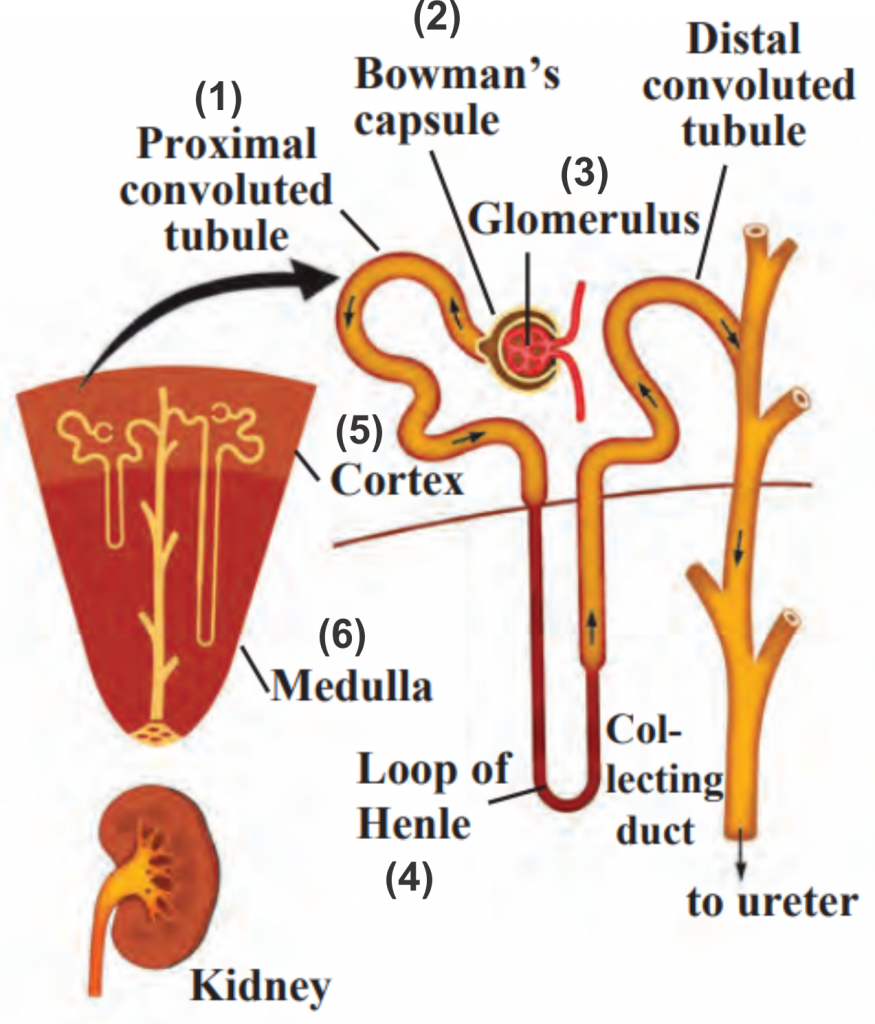 Ans
Ans
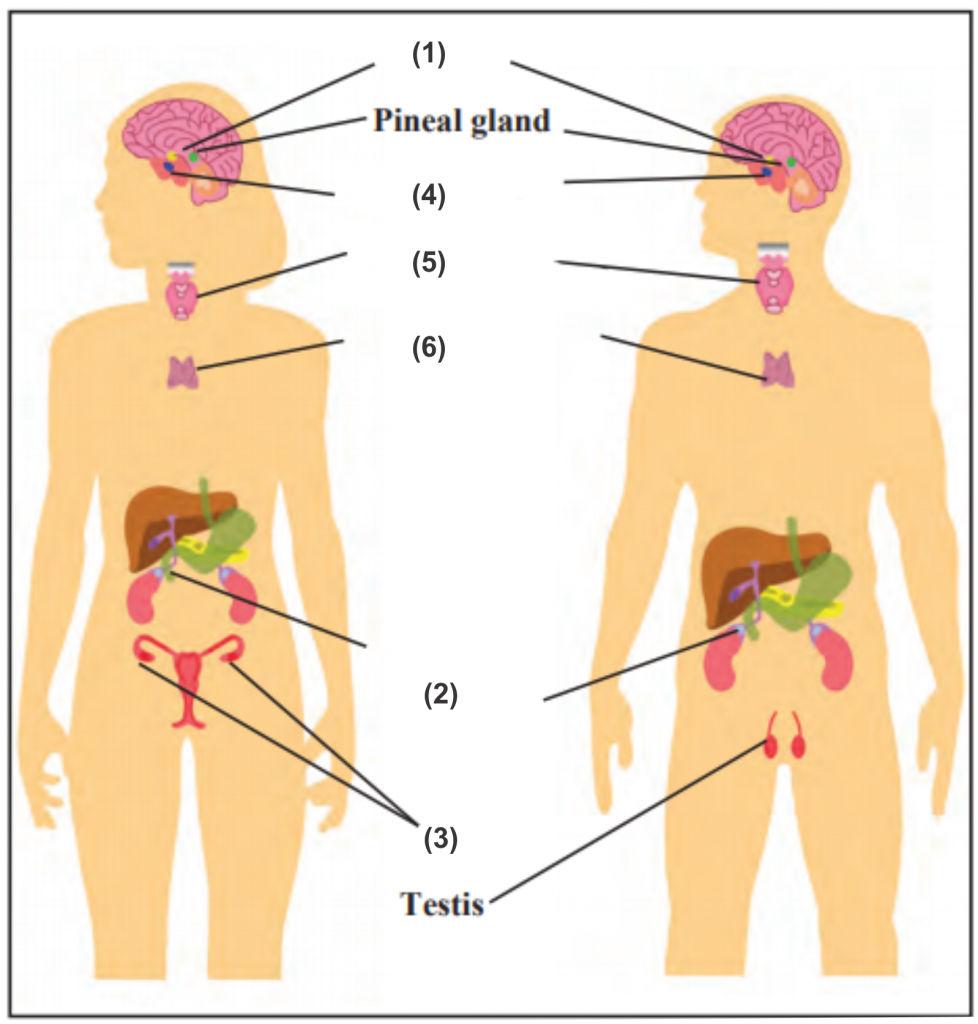 14. Endocrine glands
14. Endocrine glands
Ans
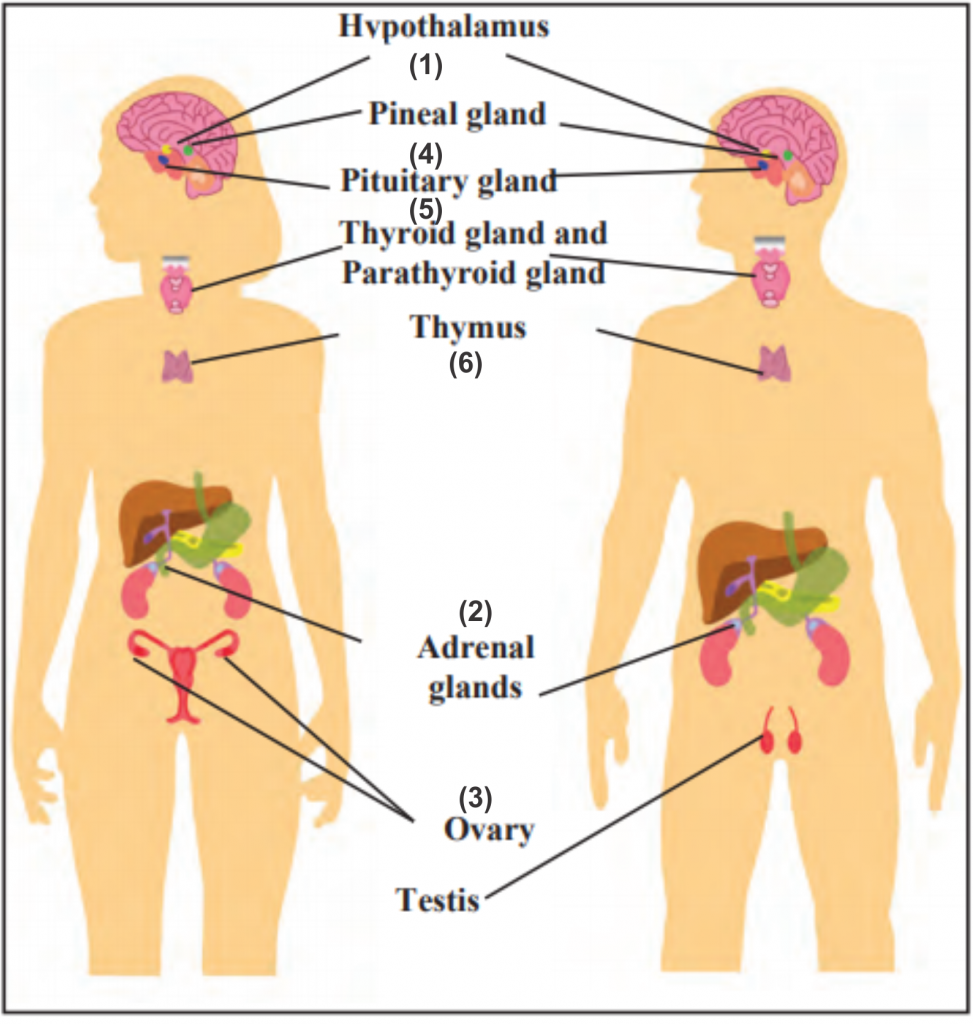
15. Human endocrine glands
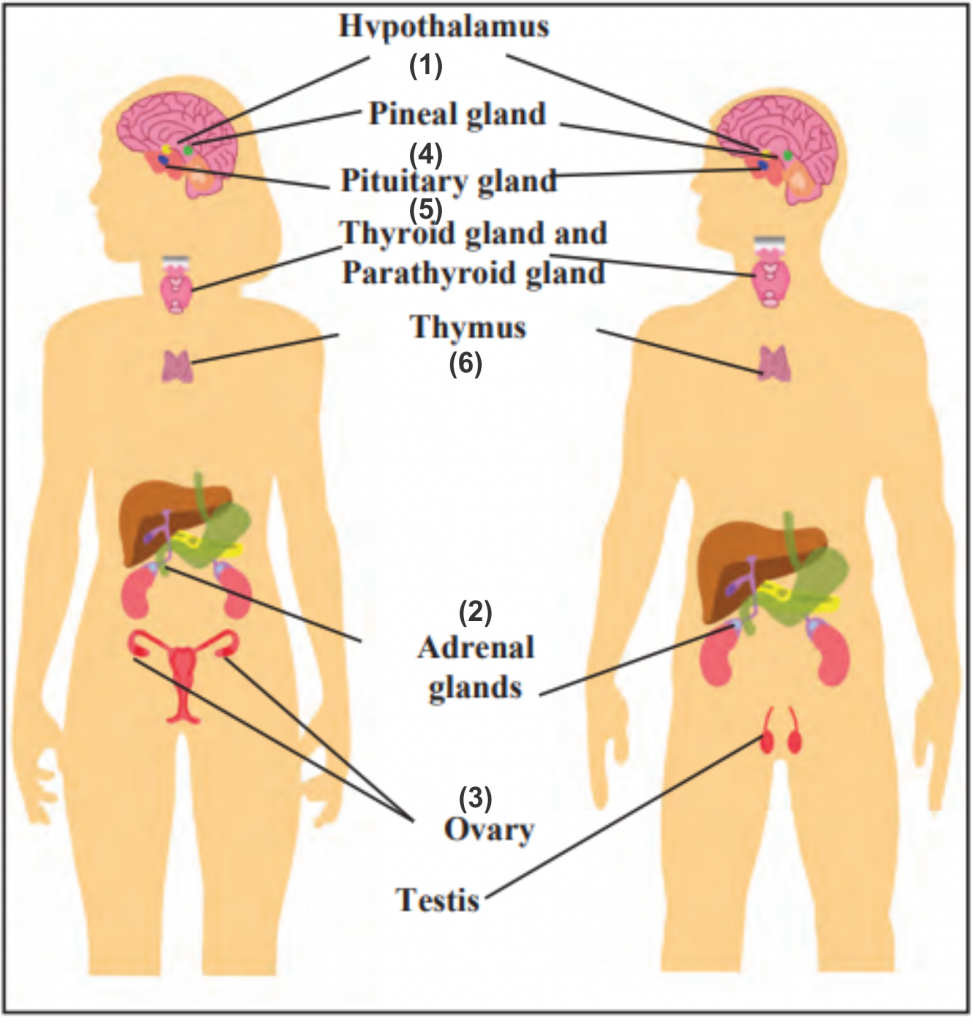 Ans
Ans
Q.21. Answer the following in detail 35
- Explain the structure of the brain.
Ans i. The central nervous system consists of the brain and spinal cord. The organization of the brain is extremely delicate and highly evolved.
ii.The brain is the main controlling part of the nervous system and it is safely located in the cranial cavity. The spinal cord is protected by the vertebral column.
iii. In the space between the delicate central nervous system and its bony covering are the protective layers called the meninges.
iv. Cavities present in various parts of the brain are called ‘ventricles’ whereas the long tubular cavity of the spinal cord is called the ‘central canal’.
v. The ventricles, central canal and spaces between the meninges are filled with cerebro-spinal fluid. This fluid supplies nutrients to the central nervous system and protects it from shock.
vi. The brain of an adult human weighs about 1300 – 1400 grams and consists of approximately 100 billion neurons.
vii. The left side of our brain controls the right side of our body and right side of our brain controls left side of the body.
Viii. In addition, the left side of the brain controls our speech and conversation, writing, logical thinking, etc. whereas the right side controls artistic abilities.
2. Explain the difference between the excretory system of plants and humans.
Ans i. The human excretory system consists of a pair of kidneys, a pair of ureters, the urinary bladder and the urethra.
ii. Urine is formed by the kidneys by separating the waste and unwanted excess substances from the blood.
The two bean-shaped kidneys are situated one on either side of the vertebral column, on the posterior side
iii. of abdomen. The functional unit of the kidney that performs the basic function of filtration is called a nephron.
iv. Each nephron has a cup-like, thin-walled upper part called the Bowman’s capsule. The network of capillaries in it is called a glomerulus. The urea produced in the liver comes into the blood.
v. When the urea-containing blood comes into the glomerulus, it is filtered through its capillaries and urea and other similar substances are separated from it.
vi. The urine is carried by the ureters and stored in the urinary bladder. Afterwards, urine is given out through the urethra.
3. Explain co-ordination in plants with the help of suitable examples.
Ans i. Co-ordination is bringing about the different processes of body in the proper sequence.
ii. Unlike animals, plants do not have a nervous system or muscular system to bring about co-ordination.
iii. Co-ordination in plants is exhibites during various kinds of movements that are mainly in the form of responses given to the stimuli.
iv. The various types of growth relevant movements are as follows:
a. Tropic Movement: Movement or growth of any part of the plant in response to an external stimulus is called tropic movement.
b. Phototropic Movement: The shoot system of any plant responds to the stimulus of light i.e. it grows towards the source of light. This type of movement is called phototropic movement.
c. Gravitropic Movement: The root system of plants respond to stimuli like gravitation. This response is called gravitropic movement.
d. Hydrotropic Movement: When the root system of plants respond to stimuli like water and grow towards source of water, this type of movement is called hydrotropic movement.
e. Chemotropic Movement: The movement shown by plants in response to specific chemicals is called chemotropic movement. For example, the growth of the pollen tube towards the ovule.
v. Many plant hormones are also responsible for various kinds of movement in plants as a response to change in surrounding. For example:
a. Auxins produced in the apical part of the shoot helps in enlargement of cells.
b. Gibberellins help in stem elongation.
c. Cytokinins help in cell division.
d. Abscisic acid is effective in prevention and retardation of growth, leaf wilting, etc.
vi. Certain movements do not lead to the plant’s growth and are called as growth irrelevant movements.
vii. In plants like touch-me-not (Mimosa), movements occur by changing the water content of the cells. These plants use electro-chemical impulses for transfer of information from one place to another.
viii. Plant cells change their shape by increasing or decreasing their water content and thus show movements.
3. Explain the structure of brain
Ans i. The central nervous system consists of the brain and spinal cord. The organization of the brain is extremely delicate and highly evolved.
ii. The brain is the main controlling part of the nervous system and it is safely located in the cranial cavity. The spinal cord is protected by the vertebral column.
iii. In the space between the delicate central nervous system and its bony covering are the protective layers called the meninges.
iv. Cavities present in various parts of the brain are called ‘ventricles’ whereas the long tubular cavity of the spinal cord is called the ‘central canal’.
v. The ventricles, central canal and spaces between the meninges are filled with cerebro-spinal fluid. This fluid supplies nutrients to the central nervous system and protects it from shock.
vi. The brain of an adult human weighs about 1300 – 1400 grams and consists of approximately 100 billion neurons.
vii. The left side of our brain controls the right side of our body and right side of our brain controls left side of the body.
viii.In addition, the left side of the brain controls our speech and conversation, writing, logical thinking, etc. whereas the right side controls artistic abilities.
4. Explain the given diagram. Nerve cell
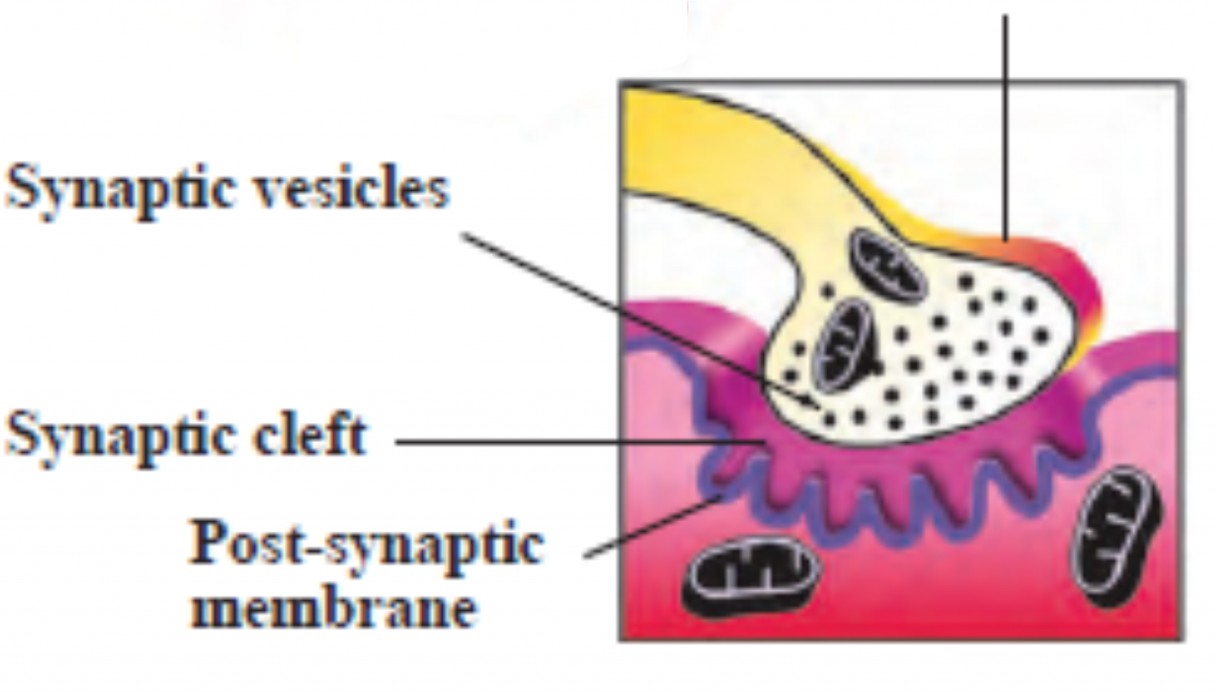
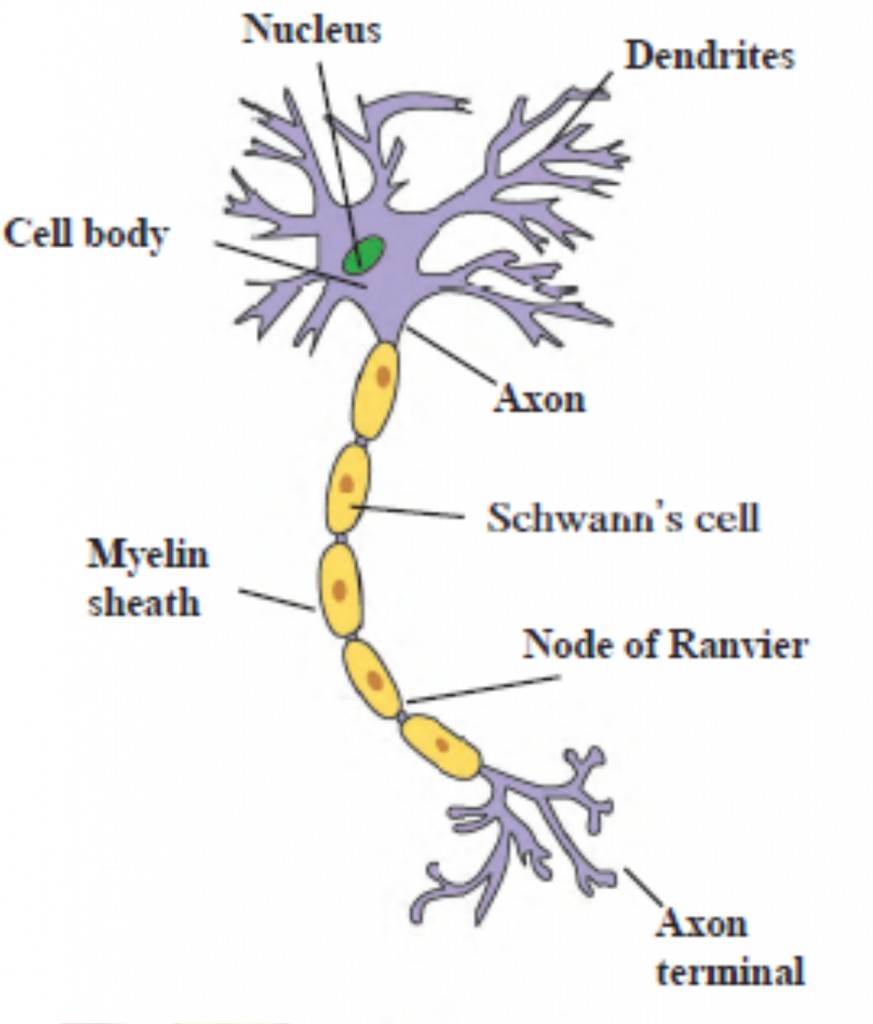
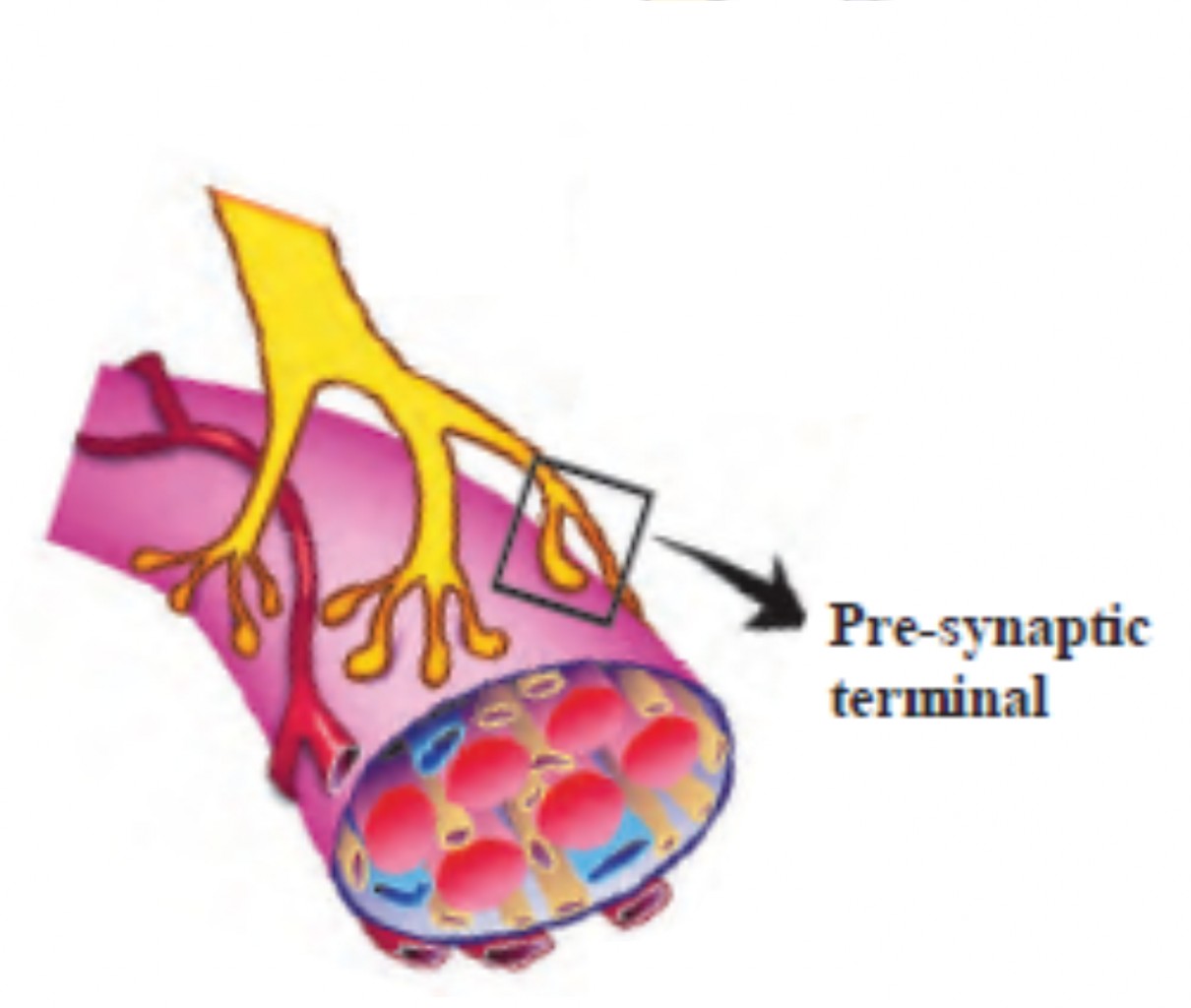
Ans i. Special types of cells which conduct impulses from one place to another in the body are called neurons.
Neurons are the structural and functional units of the nervous system.
ii. Nerve cells, the largest cells in the human the body, may measure up to a few metres in length. Nerve cells have the ability to generate and conduct electrochemical impulses.
iii. The cells that support the nerve cells and help in their functioning are called neuroglia. Nerve cells and neurologlial cells together form the nerves.
iv. All the information about our surroundings is collected by the ends or dendrites of the neuron.
v. The chemical process begins at those ends and electric impulses are generated which are conducted from the dendrites to the cell body, from the cell body to the axon and from the axon to its terminal.
vi. These impulses are then to be transferred from this nerve cell to the next. Now the impulse that reaches the terminal of an axon, stimulates the nerve cell to secrete certain chemicals.
vii. These chemicals pass through a minute space, called the synapse, between two adjacent neurons and generate the impulse in the dendrites of next neuron.
viii. In this way, impulses are conducted in the body and these impulses are finally conveyed by nerve cells to muscle cells or glands.
5. Describe the transportation system in plants in your own words.
Ans i. The food produced in leaves is transported to each cell in the plant body. Excess food, except amino acids, is stored in roots, fruits and seeds. This process is called ‘translocation’ of materials.
ii. It is carried out in both the upward and the downward directions by the phloem.
iii. Translocation of materials is not a simple physical process; it requires energy. This energy is obtained from ATP.
iv. Whenever food material like sucrose is transported towards a part of a plant via the phloem with the help of ATP, the water concentration decreases in that part. As a result, water enters the cell by the process of diffusion.
v. The pressure on the cell wall increases due to the increase in cellular contents. Due to the increased pressure, food is pushed into the neighbouring cells where the pressure is low.
vi. This process helps the phloem to transport the materials as per the need of the plant. During flowering season, the sugar stored in roots or stem is transported towards the floral buds to make them open and blossom.
6. How does excretion occur in human beings?
Ans i. The process of elimination of toxic and nitrogenous waste products from the body is called excretion.
ii. In human beings, excretory system carries out the function of excretion.
iii. The human excretory system consists of a pair of kidneys, a pair of ureters, the urinary bladder and the urethra.
iv. Kidneys separate the waste and unwanted excess substances from the blood and form urine.
v. Nephron, the functional unit of kidneys perform the basic function of filtration.
vi. Urea containing blood, enters the glomerulus where it is filtered through capillaries. Thus, urea and other substances get separated from the blood.
vii. Water and some other small molecules have the ability to cross semipermeable membrane of Bowman’s capsule.
viii. The solution accumulated in the cavity of Bowman’s capsule passes into the tubular part of the nephron
where water and some other useful substances are reabsorbed into the blood.
ix.Urine formed from remaining solution of waste materials is carried by ureters and stored in the urinary bladder.
x. This urine is then given out through urethra.
xi. Human beings are able to keep a control on urination as the urinary bladder is under the control of nerves.
xii. Though kidneys are the main organs of excretion but skin and lungs also help in excretion in humans.


